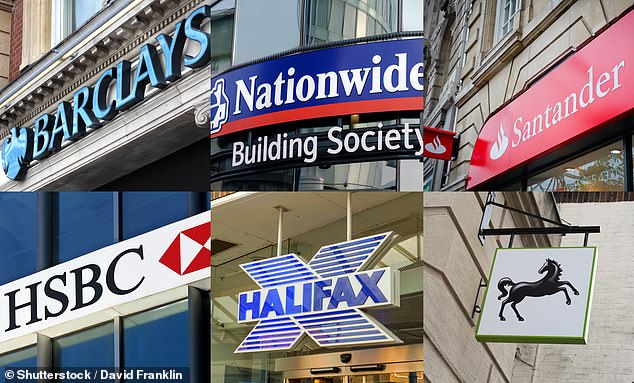
Dodge high street banks if you want a good easy-access savings rate
- Average rate paid on high street easy-access accounts now is just 1.52%
- Average rate for top 50 easy-access accounts is 3.63%
- TSB still only pays 1.35% on easy-access
High street banks are lagging seriously behind rivals when it comes to boosting easy-access savings rates, data shows.
The average rate paid on easy-access accounts on a balance of £5,000 at high street providers Nationwide, Santander, First Direct, HSBC, Barclays, NatWest and Royal Bank of Scotland, Metro Bank, Bank of Scotland, Halifax, Lloyds, TSB and Virgin Money was a paltry 0.07 per cent in 30 November 2021.
That average is now 1.52 per cent, but that is massively behind what savers can get elsewhere.
In comparison, the average rate of the top 50 easy-access accounts was 0.46 per cent at the end of November 2021 when the base rate was 0.1 per cent, according to new analysis from Investec and MoneyComms.

Laggards: Many of the High Street banks lag by up to eight times behind smaller providers
Now, with the base rate at 5.25 per cent, average rates for the top 50 instant access accounts sits at 3.63 per cent – nearly eight times higher than previously, and more than 2 percentage points higher than the high street banks.
The best buy easy-access account with Furness Building Society pays a rate of 5 per cent – and there are 25 accounts paying more than 4.5 per cent in our independent best buy tables.
Some of the big banks pay little more than 1.5 per cent on easy-access deals and have been put to shame by some of the smaller, lesser-known providers.
It means that overall, high street banks have boosted their easy-access rates by 1.45 percentage points since November 2021, while the overall 50 best buys are up 3.39 percentage points.
Loyalty doesn’t pay, so search for a better deal
Many savers continue to remain loyal to the major banks despite the low easy-access rates on offer.
Rachel Springall, finance expert at Moneyfacts says: ‘Savers must ensure they keep on top of the changing market and switch if they are getting a raw deal.
‘The savings market is benefitting from provider competition within the top end of the market, but also from consecutive base rate rises, so it’s vital consumers take time out to compare the latest offerings.’
Anna Bowes, co-founder of website Savings Champion says: ‘The high street banks have long paid as little as possible to their long suffering and loyal savers – because they could.
‘Many savers assume that their trusted bank will look after them and others simply have not had the incentive to move their cash.
‘Even if you do wait, you are still far more likely to earn more by switching away and picking an account with a provider that is prepared to pay for your custom.
‘It may be a provider you are not familiar with but as long as they are regulated by the FCA and the Prudential Regulation Authority (PRA), then your cash will be protected by the Financial Services Compensation Scheme, so you may as well take a well informed leap of faith to earn what you deserve.’
David Hunt, head of retail savings at Investec, said: ‘Savers are benefiting from the base rate rises with the top 50 instant access accounts now paying an average of up to eight times more than before increases started and fixed rate savers up to six times better off.
‘Savers cannot just rely on their provider to raise the rate they receive, and they still need to be ready to shop around and move their cash if necessary. Even among the top 50 providers there are major differences in the rates paid.’
Last month, the Financial Conduct Authority set out a 14-point action plan to ensure banks and building societies are being fair when passing on base rate rises to savers.





